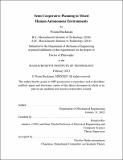Semi-Cooperative Planning in Mixed Human-Autonomous Environments
Author(s)
Buckman, Noam
DownloadThesis PDF (101.6Mb)
Advisor
Rus, Daniela
Terms of use
Metadata
Show full item recordAbstract
Autonomous vehicles have made immense progress towards deployment on public roads, yet navigating safely on roads with both human drivers and autonomous vehicles presents a challenge for even the most advanced systems. Algorithms and systems are needed for developing and evaluating socially-compliant planning algorithms for autonomous vehicles. In this thesis, we propose a semi-cooperative autonomy framework that considers the underlying social utility of human agents within the vehicle's trajectory planning and motion control. In addition, we present a new robotic platform for deploying and evaluating semi-cooperative autonomy in a safe, laboratory setting.
In this thesis, we combine concepts from social psychology with game-theoretic planning algorithms to develop semi-cooperative autonomous planners. Beginning with a single autonomous vehicle, we present Iterative Best Response with Imagined Shared Control, an algorithm that considers the Social Value Orientation of each human driver while achieving desirable game-theoretic equilibria. The semi-cooperative framework is applied to larger scale systems, a socially-compliant intersection manager for mixed human-autonomy traffic and understanding SVO impact on vehicle traffic flow. In addition, we present a visibility-aware trajectory optimization algorithm for proactive motion planning around blind spots, which incorporates a model of human driver uncertainty into a semi-cooperative trajectory planner. We demonstrate the efficacy of these algorithms in simulations of human and autonomous vehicles and study the effect of human personality on algorithm performance.
Second, we introduce the MiniCity, a 1/10th scale city environment consisting of realistic urban scenery, intersections, and multiple fully autonomous 1/10th scale vehicles with state-of-the-art sensors and algorithms. We describe how the MiniCity robotic platform is used in the development of semi-cooperative autonomy, from evaluating algorithm performance to developing new intelligent traffic systems. First, we use the MiniCity to evaluate vehicle autonomy, measuring both the impact of upstream perception on downstream vehicle performance and measuring efficiency of semi-cooperative intersection managers.
Second, we use the MiniCity's human-in-the-loop driver interface to collect user preferences for co-designing a shared controller for driving through intersections. Finally, we present a novel end-to-end infrastructure-based failure detection algorithm, FailureNet, which is trained and deployed on autonomous vehicles in the MiniCity. In all these, the MiniCity provides a safe and scalable environment for developing interactive algorithms, bringing us closer to fully deploying socially-compliant autonomy on mixed human-autonomous roads.
Date issued
2023-02Department
Massachusetts Institute of Technology. Department of Mechanical EngineeringPublisher
Massachusetts Institute of Technology